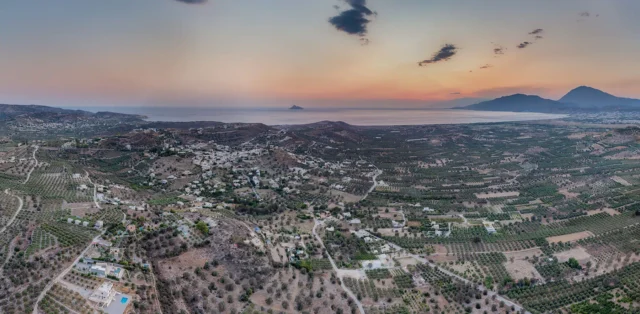
Agios Ioannis is a village situated in the southern part of the Heraklion regional unit on the island of Crete, Greece. It belongs to the Kamilari community within the Tymbaki municipal unit of the Phaistos municipality. The village is located on the southern bank of the Geropotamos River, adjacent to the archaeological site of Phaistos, making it the closest settlement to this ancient Minoan palace. Agios Ioannis lies at an average elevation of 45 meters and is approximately 61 kilometers southwest of Heraklion.
Historical Context
The village is first mentioned in written records in 1577 by Fr. Barozzi as “Agios Janus Melingha” and in 1583 by Kastrofylakas as “S. Zuanna Meligha,” with a population of 89. The first Turkish census in 1671 records it as “Ayo Yanni” with 18 households. The 1834 Egyptian census by Pashley lists it as “Haghio Ianni,” with 8 Christian and 3 Muslim families.
In May 1845, the Turks killed the New Martyr John, also known as Arnautogiannis, in Heraklion. An 1866 report on atrocities during the Cretan Revolt mentions the desecration and burning of the churches of Agios Georgios and Agios Ioannis, the sale or destruction of icons, and the killing of several individuals, including Konstantinos Arnaoutakis.
The 1875 census conducted by the Russian vice-consul I. Mitsotakis recorded Agios Ioannis as having 100 Christian inhabitants (10 families). In the 1881 Stavraki census, the village belonged to the Tymbaki Municipality and had 151 Christian inhabitants (80 males and 71 females) across 44 families.
In 1894, Agios Ioannis was inhabited by 44 Greek families. Nikostratos Th. Kalomenopoulos noted the presence of a low hill near the village with the ruins of the ancient city of Phaistos.
The 1900 census, the first conducted by the Cretan State, recorded 125 inhabitants (67 men and 58 women) in the village, still within the Tymbaki Municipality.
Nearby Churches
Two churches of historical and religious significance are located near Agios Ioannis:
-
The Church of Saint Paul and the Early Christian Baptistery: Situated near the village of Kamilari, these structures date back to the 13th century and the early Christian period, respectively. Tradition holds that the Apostle Paul preached at this location on his way to Gortyna. The baptistery, one of the few surviving examples in Crete, is a square building with a dome and frescoes depicting scenes from the life of John the Baptist. The Church of Saint Paul is a Byzantine church with a cruciform shape, a large dome, and a spacious narthex.
-
The Aghios Georgios Falandras Monastery: Located on a hill overlooking Phaistos, this monastery dates back to the late Venetian era. Although the monastery buildings are now in ruins, the church, a single-aisled barrel-vaulted structure with a tower-like belfry, still stands. The name “Falandra” is believed to be a corruption of “Filanda” (silk mill), suggesting the monks’ involvement in sericulture. Another theory links the site to Melikas, where Saint John the Stranger established the Monastery of Saint George of Douvrikas in the 10th century. The monastery was destroyed during the Greek War of Independence in 1821.
Administrative Changes
- 1925: Recognized as a settlement and attached to the Kamilari community
- 1997: Detached from the Kamilari community and attached to the Tymbaki municipality
- 2010: Detached from the Tymbaki municipality and attached to the Phaistos municipality
Population
Census Year |
Population |
|---|---|
1961 |
100 |
1971 |
92 |
1981 |
74 |
1991 |
103 |
2001 |
88 |
2011 |
65 |
Economy and Landmarks
The inhabitants are primarily involved in tourism and agriculture, particularly olive cultivation, with some also engaged in livestock farming. Tavernas in the village often feature rabbit on their menus.
The village is located near the significant archaeological site of Phaistos, the second most important Minoan city after Knossos. The famous Phaistos Disc, bearing hieroglyphic symbols, was discovered in the palace archives.
A monument dedicated to Minas Giannakakis, who fell during the Turkish invasion of Cyprus, stands at the western entrance of the village.
New Martyr John of Agios Ioannis
The village holds special significance as the home of New Martyr John, also known as Arnautogiannis, who lived there during the Egyptian occupation of Crete (1830-1840). He converted to Christianity and was later falsely accused and executed by the Ottomans in 1845 for refusing to renounce his faith. His memory is honored on May 19th.
Village Key Points
- Historical References: Mentioned in various historical records from 1577 onwards
- Location: Messara Plain, Heraklion regional unit, Crete, Greece, near Phaistos
- Dimensions: Small village
- Historical Significance: Home of New Martyr John, proximity to the archaeological site of Phaistos
- Population data over the years: See table above
- Current Status: Small village with a focus on tourism and agriculture
Access
Agios Ioannis is 4.9 kilometers away from the town Tympaki and 5.9 kilometers away from Moires





































There are no comments yet.